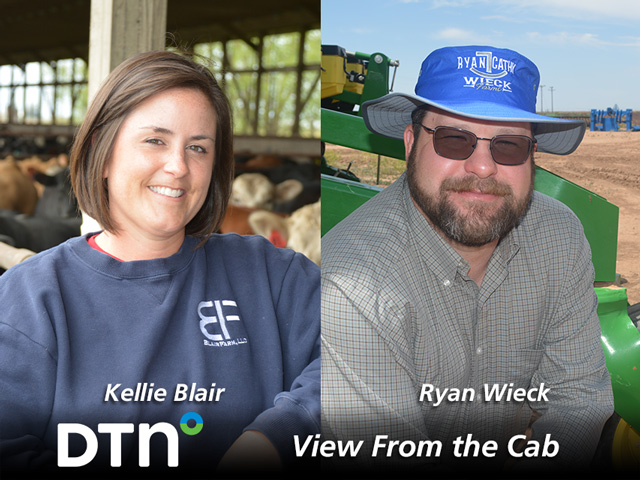View From the Cab
Weathering the Storms: 2021 the Year of Farm Uncertainty
DECATUR, Ill. (DTN) -- There's no such thing as quitting time for Kellie Blair. Planning for the coming year starts before the year ends. One season tends to blend into another on diversified farms where enterprises depend on the other.
Still, the Dayton, Iowa, farmer has noticed that the uncertainties encountered during the current crop season have added the need to frequently interject the word "flexibility" into her vocabulary. From early weather worries to the decision to book and apply anhydrous this fall, the need to roll with change became a necessary strategy this year.
Ryan Wieck agrees. The Texas Panhandle farmer felt the uncertainty of supply chain issues as inputs such as glyphosate and machine parts became scarce this season. Meanwhile, skies refused to bless his thirsty crops to the point that even irrigation couldn't compensate. The lack of soil moisture has him reevaluating the 2022 cropping mix and how many mama cows limited available resources can support.
The ordinarily good-natured Wieck admitted that the rocky season frustrated him at times. "I'm pretty proud of what we've accomplished this year with so little moisture. But sometimes it was hard to keep my head up. Then, someone would read one of these articles about what we're going through and send an uplifting note. I was able to tell my story. People listened and I've made contacts from all over. That made things look brighter," he said.
Blair and Wieck have been participating in DTN's View From the Cab series since May 2021. This is the 27th installment of the diary-like report following life on the farm and in the field throughout the growing season. It is the official end of the series, but expect to see Wieck and Blair crop up in other features. View From the Cab alumni become valued sources for DTN.
This is the 16th year for the View From the Cab series. Interested in participating next year? Send us an email at pamela.smith@dtn.com.
Read on for a recap of the season for Wieck and Blair and what's happening in their world this week.
RYAN WIECK -- UMBARGER, TEXAS
In many ways, Wieck comes off the 2021 season just as he went in: parched. A lingering drought continues its chokehold in the area where he farms near Umbarger, about 30 miles south of Amarillo in the Texas Panhandle.
While farms around him soaked up some moisture this year, the bulk of his fields have received less than 7 inches of precipitation since Jan. 1.
When we first profiled Wieck in May (https://www.dtnpf.com/…), he talked of his grandfather, Ed, who often said: "The Texas Panhandle can promise so much and give so little or can promise nothing and give you so much," Wieck said.
Those words seem prophetic as Wieck reflects on the crop year. "We just had a horrible year with the lack of rainfall. The fact we were even be able to harvest a crop, in my opinion, is a huge win," he said.
Wheat and cotton are the mainstay crops. Wheat on fallow ground (cotton ground harvested December 2019 and planted to wheat October 2020) made between 24 bushels per acre (bpa) to 40 bpa, depending on rain totals in those fields. Wheat delivered to the flour mill averaged 13.9% protein.
P[L1] D[0x0] M[300x250] OOP[F] ADUNIT[] T[]
At question right now is what to do about the wheat seeded for 2022. Poor moisture conditions have left it struggling to emerge, and survival is a question in Wieck's mind. For crop insurance purposes, the final plant date for wheat has passed, but there's a 15-day late-planting date that ends Nov. 30.
Cotton harvest is still ongoing. However, this week, the cotton stripper has been parked several days awaiting repairs -- a situation that makes Wieck cringe. This is the first year he's used a stripper that bales cotton.
"I'm amazed what the machine can do when it is running and that I can cover so many acres by myself. That's been helpful because labor has been short this fall. But I'm also amazed by how many moving parts there are in this new machine and how much there is that can go wrong," he noted. When parts can be found, they are often hours away and must be personally picked up.
Milo was the big disappointment of the year for Wieck. "The grain sorghum crop just never developed a root structure. It got planted when we had a brief period of soil moisture, and then the weather turned hot and dry. Plus, we had some hail damage," Wieck said.
The cotton suffered with hail and 2,4-D damage when neighboring sprays drifted. Wieck also reported that first-position fruit was missing on the bottom branches as dry weather and cloudy conditions took their toll and caused fruit abortion.
"Still, looking back, I think we did a really good job managing everything -- from our seed selection to available water -- to be able to harvest a crop," he noted.
"It was a hard year, but we have been able to manage through the difficulties and still bring dollars in to pay the bills. It was sometimes hard to keep the head up high, but we kept trudging forward. I think we must be willing to tell ourselves we did an awesome job despite the odds -- that's how we keep going," Wieck said.
After cotton harvest is complete, he plans to spread cow manure on those acres. "I'll pull soil samples to see where I need fertilizer and try to get a game plan. I've got my eye on EPA to see what decisions they might make about dicamba as I work on seed selection.
"I also plan to do a full assessment of what I need in the way or parts or repairs on equipment to think about what kind of inventory might be needed. I'm thinking contingencies -- what I can I do if I can't use this or what happens if I can't get a product," he said.
"I'm going to look at what I know I can grow and stick with it for next year. I think I've given up on sorghum as a dryland crop. Cotton works better here because the taproot will reach down for water."
KELLIE BLAIR -- DAYTON, IOWA
Blair can't quite put her finger on why life seems so uncertain of late.
"Maybe it's our age and the kids getting older; maybe it's trying to come back after a year when COVID canceled most everything. But I feel the need to slow down and focus on what matters most and really prioritize," she said.
When DTN first introduced Blair, the focus was on juggling farm duties with family and life (https://www.dtnpf.com/…).
Throughout the crop season, she brought that real-life dance to the page as children free for the summer cartwheeled through the living room and she fought to find time to work in a workout for herself beyond scouting crops.
The corn and soybean crop seemed initially hesitant to get up and grow this year. While the seeds went into the ground in a timely fashion, cool weather and lack of moisture made for some erratic germination in a few fields, Blair noted.
Finally, well-timed showers brought relief. Heat and humidity ratcheted upward in true Iowa fashion. "Every time we seemed to be to the point where we couldn't hang on longer, we'd get enough rainfall to get us through," Blair said.
"This year has been a testament to some of our conservation measures and the germplasm we have available in current hybrids and varieties," she added. Overall, yields met or surpassed farm averages.
Blair Farm concentrates on integrating soil conservation and water quality into a system of growing corn, soybeans, alfalfa-hay and small grains that includes cattle as part of the equation. Livestock operations include custom-fed pigs, cow-calf pairs and a beef feedlot that finishes custom and owned cattle.
This year, the farm also started a direct beef sales business. That business hit a snag late summer when one of their main processors had a fire. "We're still learning this business, but we're committed to trying to close the marketing loop and make this viable. But there is a learning curve," she said.
A new 24-row planter will be put into service in 2022, but it is already making changes -- such as how wide to make end rows when running the strip-till bar this fall.
"We were having issues baling corn stalks this year and traded balers. So, we have sped up baling this fall and have a good supply, which will help us stretch our hay this winter," she said. The farm is trading for a new corn head for 2022.
Fertilizer prices and uncertain supplies encouraged them to apply some fall anhydrous this year, which will change their workload next spring. "We're just looking at everything and changing what we can without giving up things like cover crops, that we really believe in," she said.
"There were several things that we did kind of new this year that we are learning from as a family -- such as 4-H. Having our children step up and be more involved in the operation is hopefully sending the message that when we work together to lighten the load, then we have more time to do fun things too.
"Every day, every week, every year, we learn a little bit more about ourselves and about our farm. And that learning gets us excited and maintain enthusiasm to do it all again," she said.
Pamela Smith can be reached at pamela.smith@dtn.com
Follow her on Twitter @PamSmithDTN
(c) Copyright 2021 DTN, LLC. All rights reserved.




